BIOS -
BIOS is an acronym that stands for Basic Input/Output System. It is meant to control your product at a very low level. As of right now there are three regularly used BIOS formats (there are actually more than that but there are three common ones). These are the AMI (American Megatrends Incorporated), Award, and Phoenix. The BIOS on the P8Z77-M Pro is Asus’ implementation of the UEFI standard and like what we have seen on other motherboards it is clean and responsive. Check out our video of the BIOS in action on YouTube.
Overclocking –
The Asus P8Z77-M Pro was a little tricky to overclock. Unlike the other two boards we have tested with our Core i7 3770K we had to tweak the IGP voltage to get stability at anything over 4.6GHz. It was not a big tweak (0.01), but it is important to not if you are looking to push this board. Once we identified this we were able to hit the current maximum on our Core i7 3770K of 4.8GHz. As we noted in our review of the Core i7 3770K we feel the majority of the limitation here is certainly in the CPU at the moment due to the die shrink and everything that goes with it, still 4.8GHz without much effort it still not bad. 
Of course overclocking is a picky subject. I can buy to identical CPUs from the store and they will not always perform the same way under stress. This is the same with motherboards, RAM and GPUs. So again it is important to keep in mind that our results represent a specific hardware configuration. Yours may be similar but will rarely be identical.
Overclocking Tools -
As with other Asus board the suite of tools that you use to overclock the P8Z77-M Pro is Ai Suite II. This contains many applications that were separate not that long ago. You have items like TurboV EVO, Digi+, and more all in one package. We will cover the ones that relate to overclocking here starting with TurboV EVO. 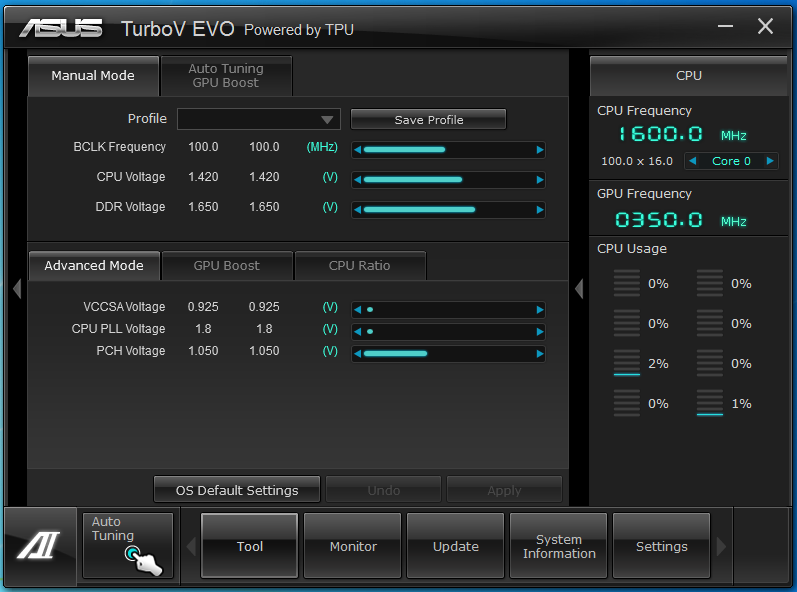
Over the years we have watched as Asus has improved their Windows based overclocking tool and are seeing the culmination of that work. Here under TurboV EVO you have a good selection of the most important options for overclocking your CPU and GPU. If you are new to the overclocking game you can use their Auto Tuning GPU Boost option that will give you a quick OC or an extreme one (the difference should be easy to understand). We opted for the Extreme and after only three re-boots we were given a 4.6GHz overclock. We were surprised that the system went for a BLCK adjustment instead of just a raw multiplier increase, but it did. 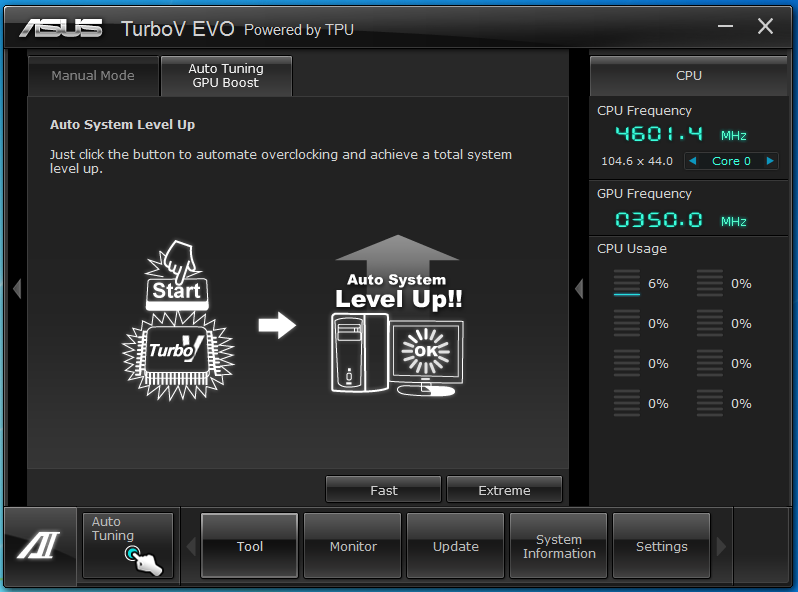
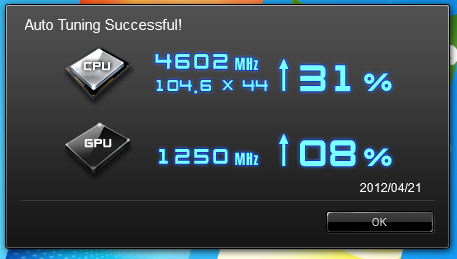
If auto overclocking is not your thing then the tools in TurboV EVO might be more to your liking. Here you can adjust the BCLK along with a few of the voltages that are required for stability (although most can be left alone). You can also independently adjust the GUP maximum clock setting and IGP voltage. To add to your overclocking fun you can also opt to adjust the multiplier for the cores in groups (from one to four). For example you could overclock a single core to get a higher speed and leave the others alone.
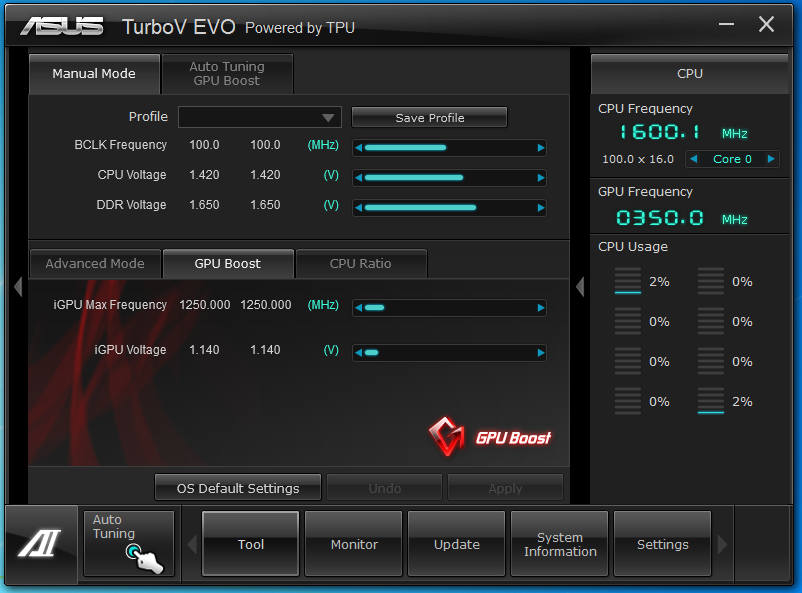 |
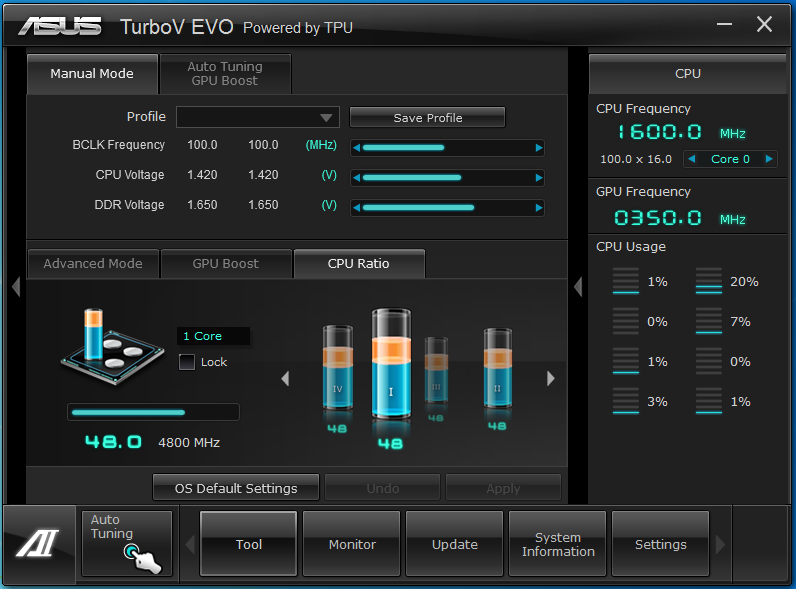 |
Next up for overclocking controls is the Digi+ power controls here we see them as they are laid out during our overclocking. The P8Z77-M Pro does not have the Smart Digi+ options so you will want to be careful making adjustments here. For those that want to track what is going on during their overclocking sessions you have the Asus Probe II as well as a utility to let you record the information gathered by the onboard sensors. 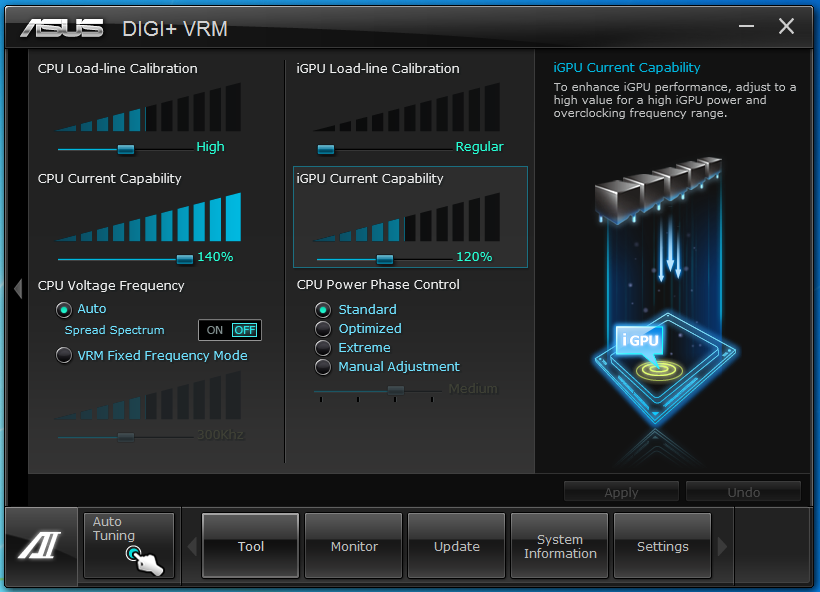
The Test System and Comments -
Our test system is built on an open bench. This has two effects on testing. First it allows us to see everything and also to setup and disassemble the test rigs quickly. Second it means that we cannot gauge the potential air flow found in a normal case. The air is pretty stagnant; some may say this is a great neutral testing method and it can be. However, it does mean that the temperature reading taken off of the components are not accurate to what an average consumer would see. This means that your thermal performance will vary from what we see here.
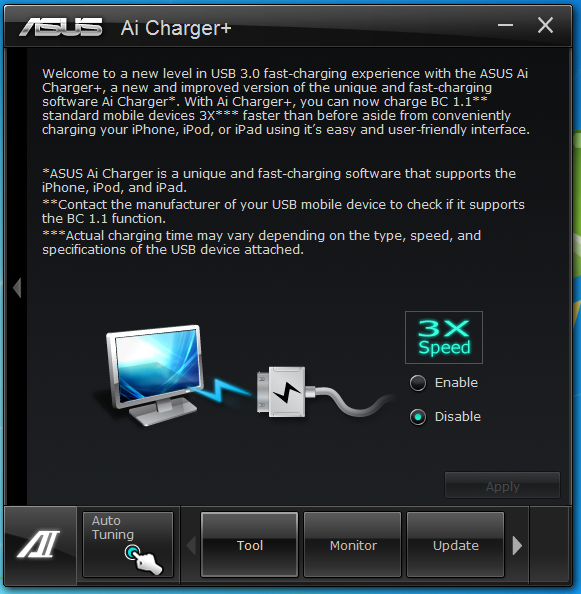 |
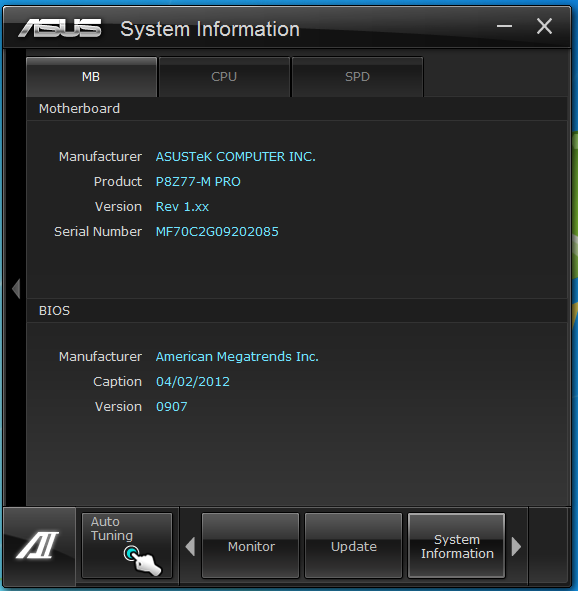 |
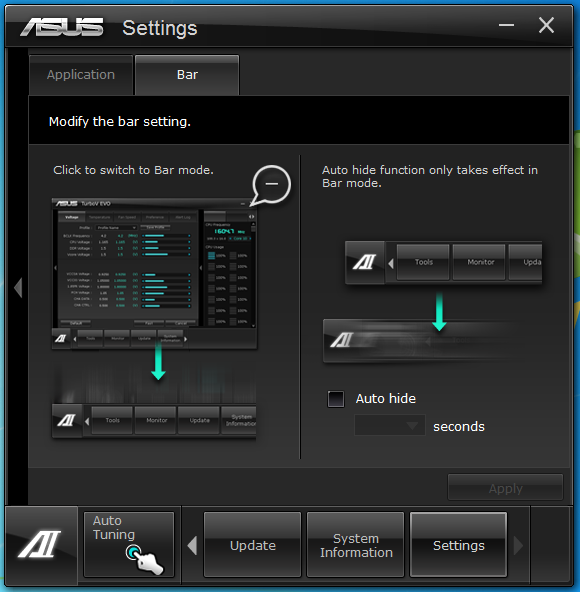 |
Our time with the P8Z77-M Pro was very nice (with the exception of the issue during overclocking we noted above). It is a clean board and the installer that comes on the DVD will get everything you need installed and running quickly. As this is at the lower end of the Asus line up the feature set is not as large as what we saw on the Maximus V Gene, but as we have said before it is still very nice for this level of product. 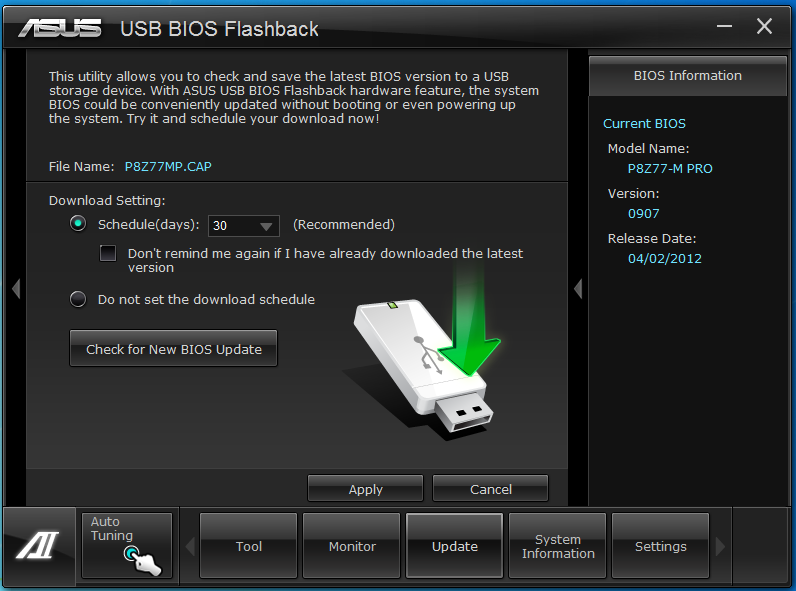
Performance testing overview -
Our testing is a little different than most. We combine both synthetic and real-world applications to simulate the types of performance common to the individual products. For motherboards this means that we run roughly six synthetic tests and two real-world. We will be expanding the real-world testing in the near future. But there is more to performance than just the raw numbers. As there are multiple components and sub-components on a motherboard there each item can have a distinct impact on the way the product will perform once you get it in your system. It is important to note not only the actual results but what they mean to you as a potential consumer. We will try to give this information to you. But we do not just cover the performance aspects that are measurable. We also talk about the components that might not have a direct benchmark. These are items like Audio Quality, ease of use and installation.
Section 1 Subsystems
Memory -
Memory performance is very important on a motherboard, especially when you have a CPU with multiple cores and threads. If you have slow memory your cores and threads can become starved for data to execute. To test memory performance we run both Sisoft’s SANDRA and AIDA64. These two combine to not only give us accurate numbers but to validate each other. For testing at stock speeds the memory is hard set to 1333MHz while overclocking testing is done at the highest stable speed for the voltage of 1.65v this is due to the different memory dividers for each CPU. As such, the memory speeds will vary greatly. This means that the overclocked numbers are a little misleading and while they can show a trend are really only included to show if a board has a problem with memory performance at high clockspeeds.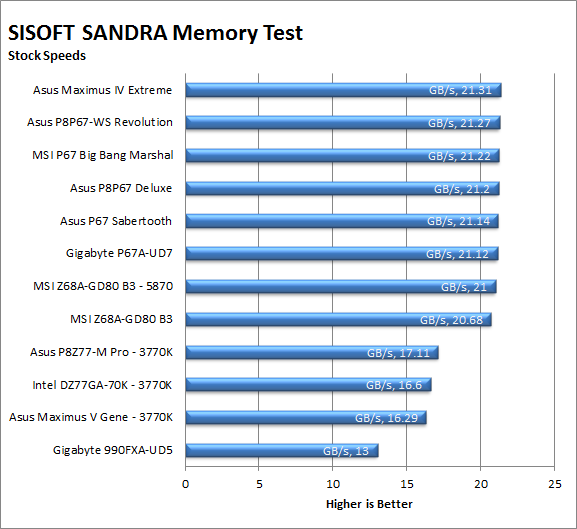
Interestingly the Asus P8Z77-M Pro is at the top of the Z77 motherboards we have tested so far. If this has to do with something in the BIOS or the lack of additional components trying to use system memory we are not sure. Still the overall memory performance of the Ivy Bridge and Z77 combination is a little lower than what we would have thought. Still even with this lower memory bandwidth score we would expect to see solid performance in rendering and transcoding thanks to the new AVX instructions in Ivy Bridge. 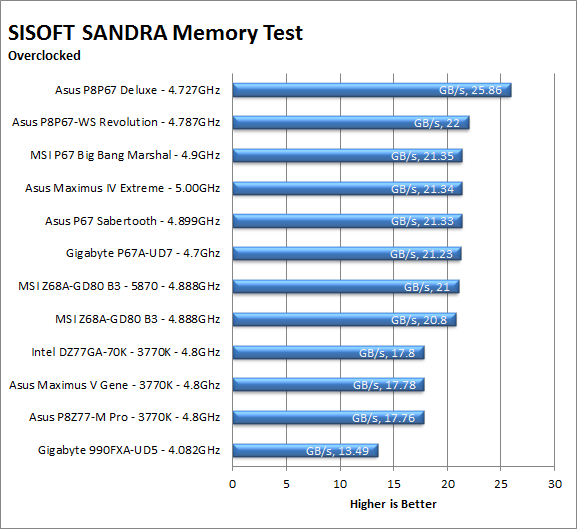
Drive performance -
Drive performance is also one of the major subsystems that goes to make up the performance of a motherboard. For our testing we use Sandra and AIDA64 again. We only test with single drives for each type of controller present on the motherboard (unless it is a professional product where we will use RIAD 5 and/or 10). We have also begun using a Seagate PS-110 USB 3 external HDD and a Kingston HyperX USB 3.0 Flash drive for our USB 3.0 performance. As a side note, we include the overclocked numbers here to make sure (again) that you are not going to see a major drop in performance due to minor instabilities at high clock speeds.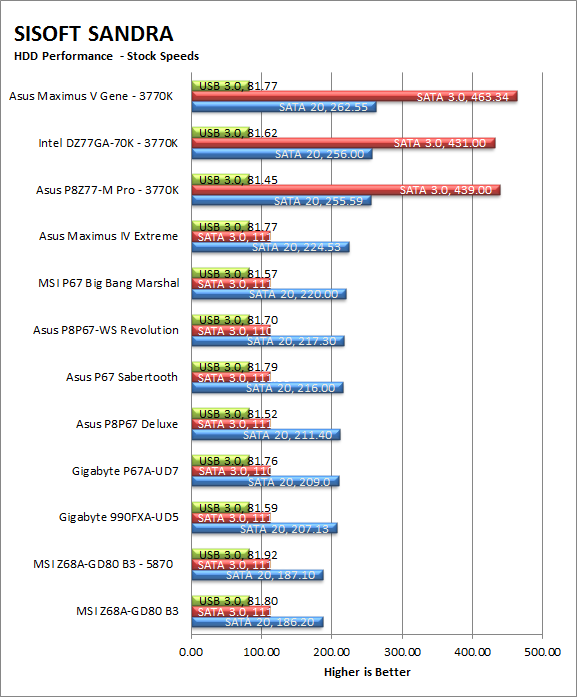
For HDD performance (well ok really SSD performance) we find that the M Pro is faster than Intel’s DZ77GA, but is not as fast as the Maximus V Gene. This is not unexpected as the Gene is a much better put together board (with better components). When we overclocked the M Pro it did pick up where as the Gene lost performance. 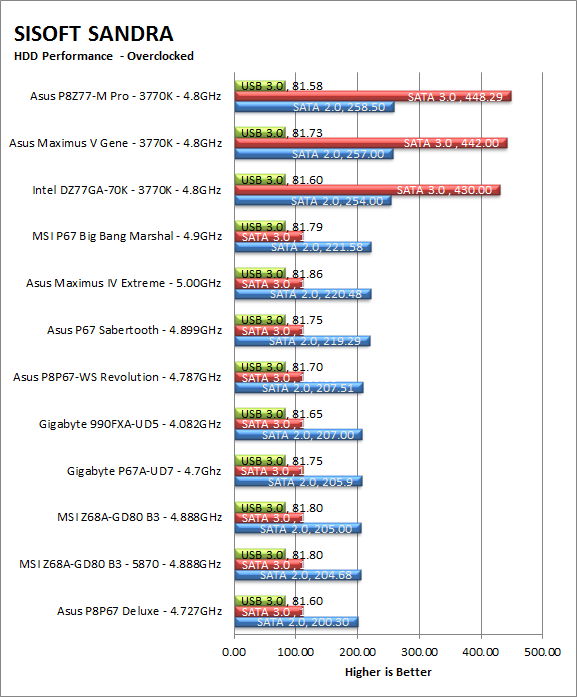
Using the USB 3.0 Boost feature in the Ai Suite II utility we were able to add about 20 additional MB/s with the Kingston HyperX USB 3.0 flash drive we have (from 247.88 to 270.73 on the Intel controller and 245.3 to 268.70 for the ASMedia controller). These are not bad improvements at all. We are still working on a USB 3.0 device that supports the true USAP mode so we can see what this new feature is really capable of.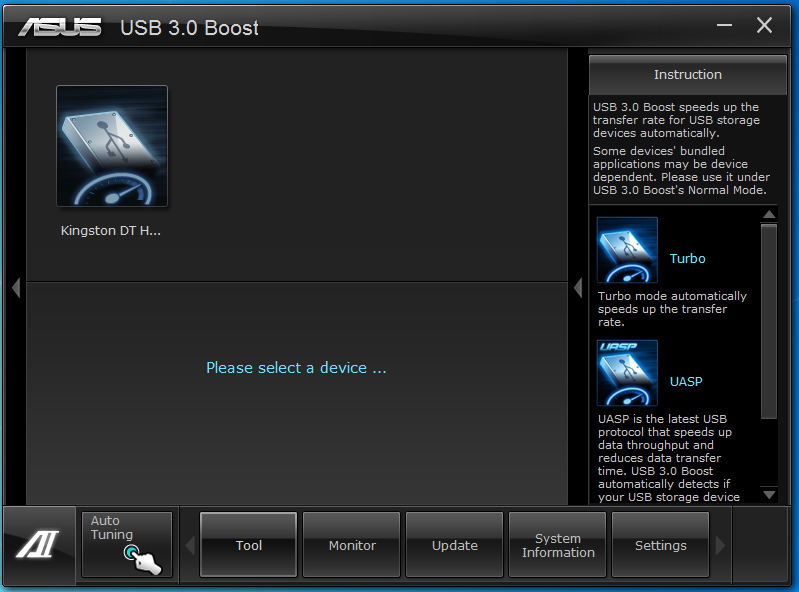
Power -
Power efficiency is another of those misnomers that we get caught up in. We hear about idle states and power gates. But what does that mean to you and I? On the surface having power management that reduces idle power sounds great and can be a benefit to someone that leaves their system on for long periods of time (and inactive) but how a system handles power under load and the delta between the two states is often more important than the idle power usage numbers. We use only P3 Kill A Watt instruments for measuring power. 
The power draw on the P8Z77-M Pro was not bad although it was still at the bottom of the Z77 boards we have tested. This should not be too much of a concern as you can still turn on Asus’ EPU which will help to reduce this quite a bit at idle and with the right profile can even knock some of the power draw back under load. 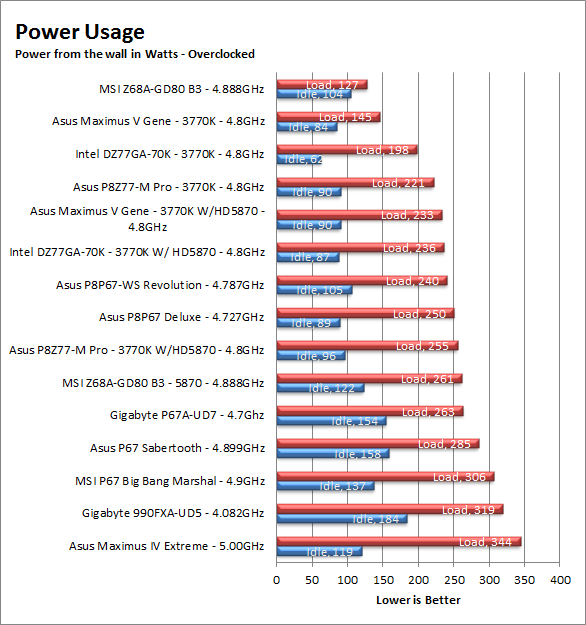
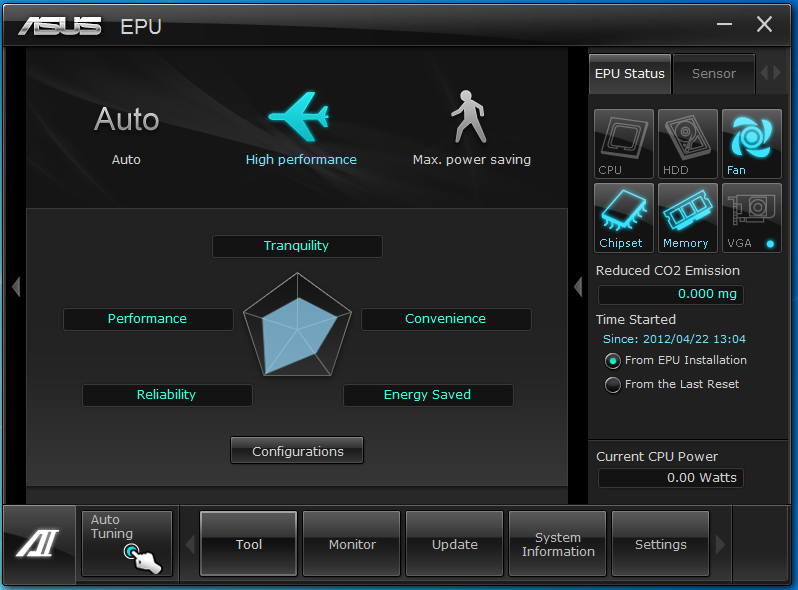
Cooling (Board Level) -
Board level cooling is an important factor in product performance and longevity. Components like the chipset, VRM modules and even capacitors need to be kept relatively cool to prevent failure. As these parts are made of silicon, they have a thermal breakdown threshold; or melting point. At that temperature the actual transistors built into chip will begin to deform and break down. Granted, the threshold is often very high, but you still need to make sure that components stay away from this level of heat for longer product life. 
As we mentioned in our walk around of the board (in the first part of our review) we were concerned about the cooling on the Z77 PCH. It looks like this was a valid concern as we saw some fairly high temperatures. The high level of heat generated could be concerning when it comes to component life and also stability. We would recommend making sure the case you put the P8Z77-M Pro in has plenty of good air flow.- Update- It appears there was an issue with our Fluke 62 Mini. The internal switch that changes the reading from Farenheit to celcius was not working as it should. we have made the calculations to adjust the temps and you can see the results below. We apologize for this as the reading still showed c in the display. However it is obvious that it was not reading properly when we used a second IR thermometer for verification after user comments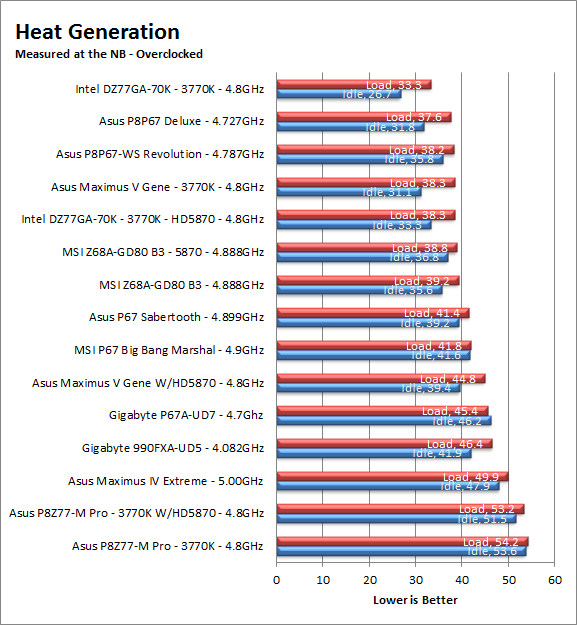
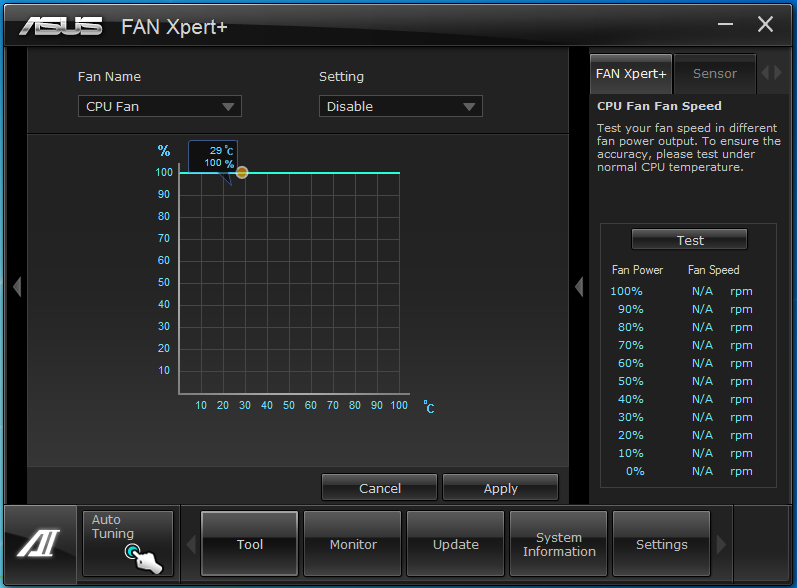 |
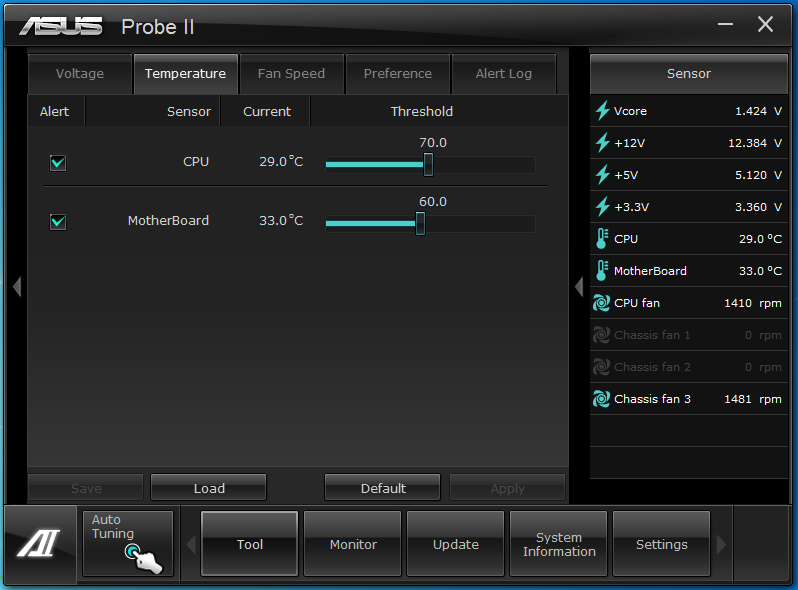 |
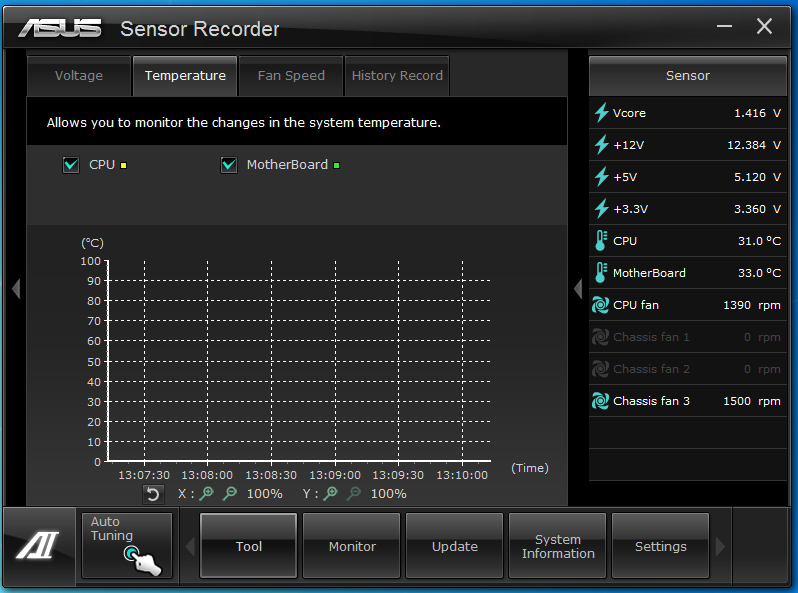 |
Audio -
Audio is highly subjective. What we find pleasing may sound “off” to you. That is always going to the problem with testing audio; results will vary too widely depending on the tastes of the listener. However, there are ways of measuring the audio output with an objective ear. There is also the issue of audio causing performance issues in gaming and video playback. The reason this is a potential source of concern is that all onboard audio CODECs (Compression/Decompression) are CPU controlled. This means that while the audio chip controls the audio levels and effects of the audio the actual work is done on the CPU. Usually this will not be a problem with today’s powerful CPUs. Even the lower and consumer level products can handle high-end audio these days. But again there is the chance that a bad design or software will hinder your system and performance. On the other side the limits of board space, cost, etc will also prevent the level of audio quality you can get from an add-in board. We test all audio parts with three media types, Movie (DVD), MP3 Music, and Gaming. These are pushed to our Tec On model 55 Tube Amp to see if we can detect any signal issues in the reproduction.

The audio on the P8Z77-M Pro is pretty standard. It is a Realtek ALC892 audio CODEC and has an Asus branded control panel. We actually like this panel much better than the stock one as it is easier to view and also to navigate around.
Networking -
This one is something that is a requirement anymore. If you have a computer, the chances are good (like 99%) that you are also connected to high-speed internet. With this you need a good and solid LAN chip to make sure that your data flows properly out and back. 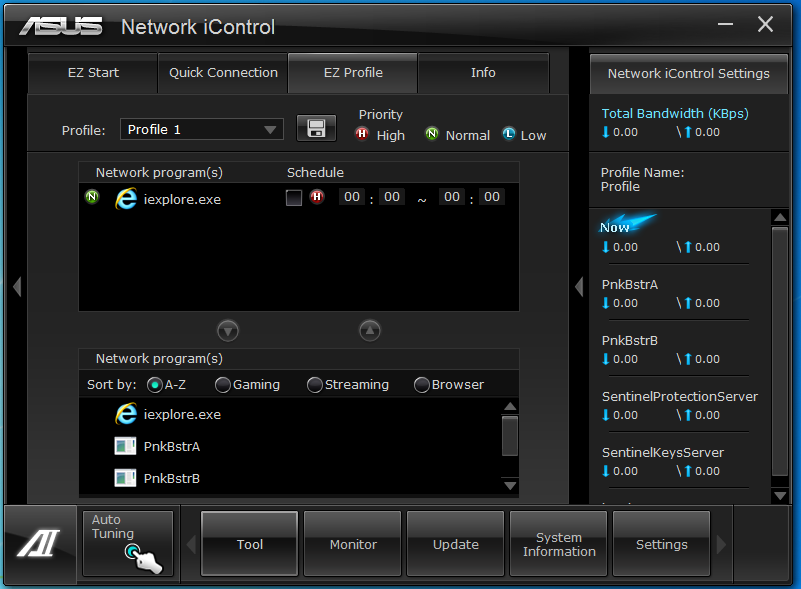
The networking on the P8Z77-M Pro is not an Intel LAN controller like we see on the ROG line and even on the P8Z77-V and –V Deluxe. Here you have a Realtek controller (a Realtek 8111F Gigabit Ethernet controller) which does the job as far as getting your packets back and forth on the network. Asus has added in a nice feature though. It is the Network iControl option. This is a software based Quality of Service utility that is one of the easiest to use that we have seen. To add an application to your QoS profile just highlight it and click on the upward triangle. From there you can set it to normal, low or high priority; very simple.
Section II - Performance Tests,
Synthetic
In this section of testing we cover the synthetics. These are tests that run a scripted sequence of internal APIs or that use another installed application to perform a series of scripted events. They are great in that they can provide reproducible results across various platforms. On the down side, synthetic tests can be fooled with driver tweaks and optimizations. In some cases it is necessary to rename the .exe file to something generic to discover if this is the case. In any event when this is needed (when a test shows a drastic difference in performance over the renamed exe) we will note this and show both results for comparison.
PCMark7 -
PCMark7 is the latest general performance test from FutureMark. As each generation of this benchmark has evolved and developed we have watched them add more and more realistic tests to this suite. With this generation we find more media tests, (audio and video transcoding) moving of large files, multiple web page rendering, and much more (the even added DX10 gaming). We use the Overall Performance and Common Usage suites in our testing.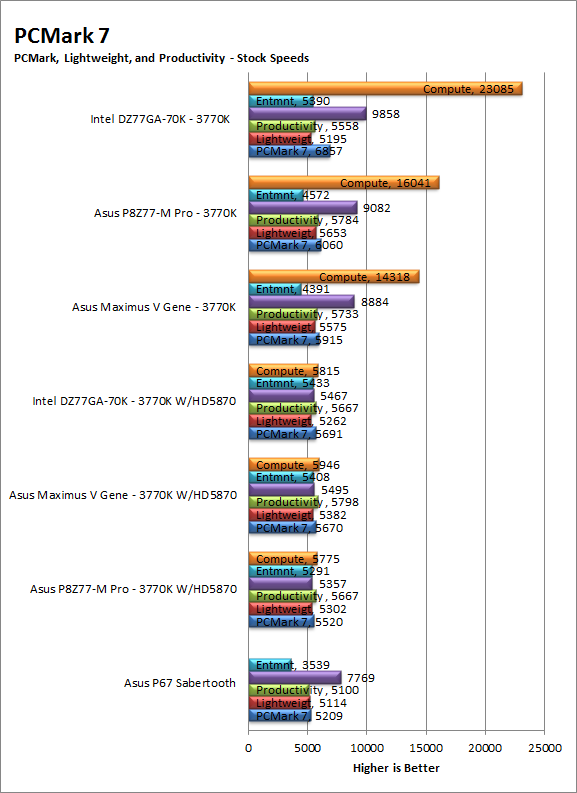
Well talk about a surprise the Asus P8Z77-M Pro shows up as a little faster in general computing than the Maximus V Gene. This will certainly be good news for people looking to pick this board up, but might be a little upsetting to a few Gene owners out there. This we back to “normal” during our overclocking tests though, but even with that you can see that the M Pro will do what you need for most general computing needs. 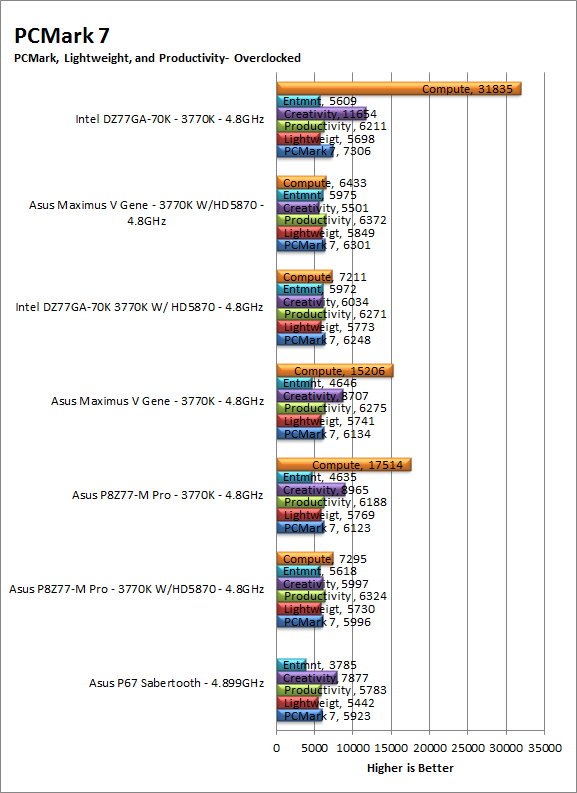
3DMark 11 -
3DMark 11 is the other Futuremark test that we run on our motherboards. This test simulates the typical tasks that a GPU (and system) would have to perform to provide you with a good gaming experience. It is based on the DX9, DX10 and DX11 engines but can only be installed on Windows Vista or later. The suite of tests covers DX9, DX10, and of course DX11 rendering; it also covers AI computations and physics. That’s right I said Physics the latest version of 3DMark uses a Havok physics engine. This removes the advantage that nVidia had with 3DMark Vantage. 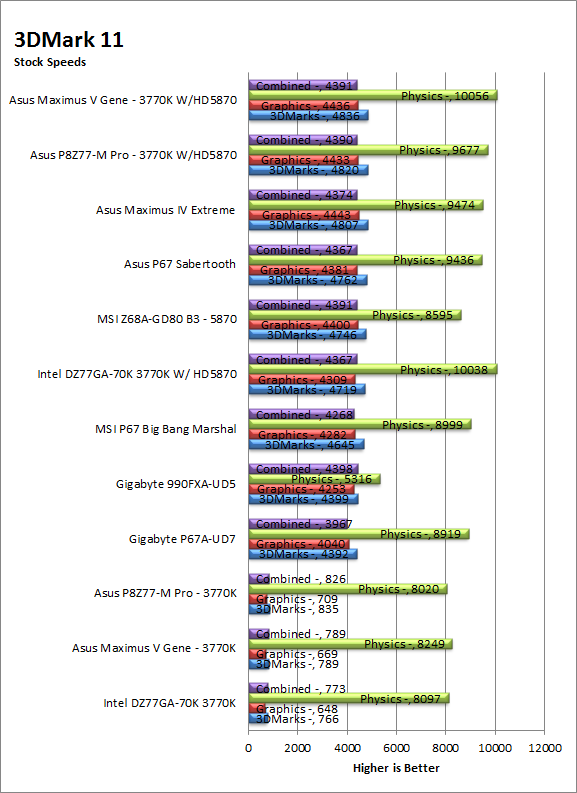
Under 3DMark 11 we find that both Asus boards do very well with the M Pro just a little behind the V Gene when using a discrete GPU. When using the IGP things are reversed though. Again this could be not much more than a BIOS tweak for the V Gene, but still it does show that you can expect good graphical performance from the M Pro and possibly good gaming. 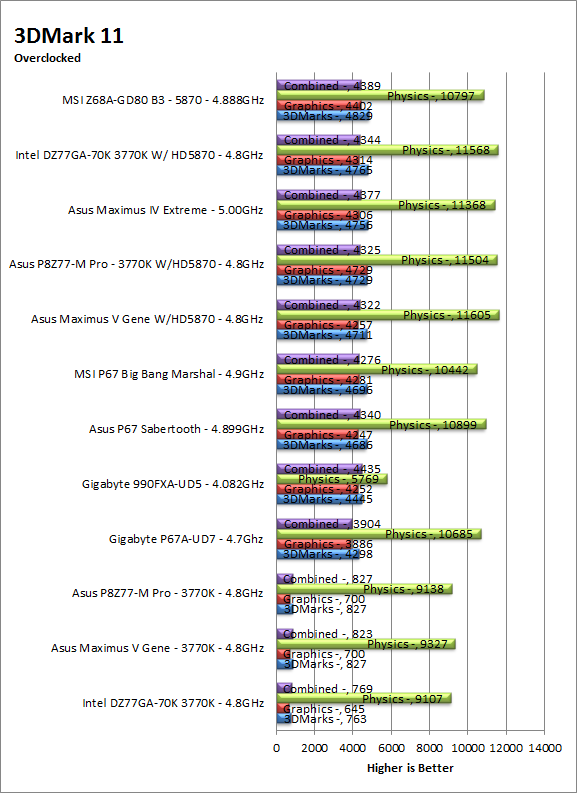
HyperPi 0.99b -
HyperPi is a front end application that allows you to easily run multiple instances of the SuperPi application. SuperPi, for those that are not familiar with it, is an application that measures the time it takes to calculate the number Pi out to as many as 32 million places. This calculation is then checked and run multiple times (up to 24 for a 32M run). This test stresses the CPU, Memory and HDD as data is handed off between the three. If there is a weak link, HyperPi will show it. For our testing we run the 32M test on as many cores (and threads) as the CPU has available. The slowest CPU time is then recorded. 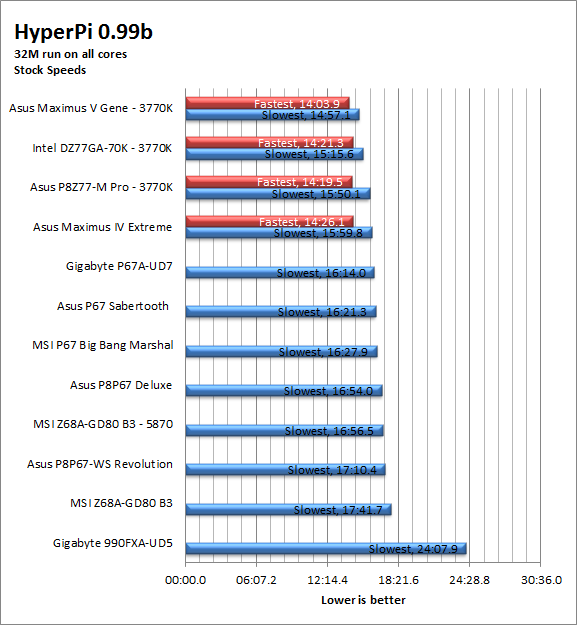
For complex computations the M Pro can handle its own and was faster than any of the other P67 or Z67 boards running our I7 2600K (even on the Maximus IV Extreme). It was at the bottom of the grouping for the three Z77 boards that we tested though. The M Pro picked up alittle during our overclocking testing though. 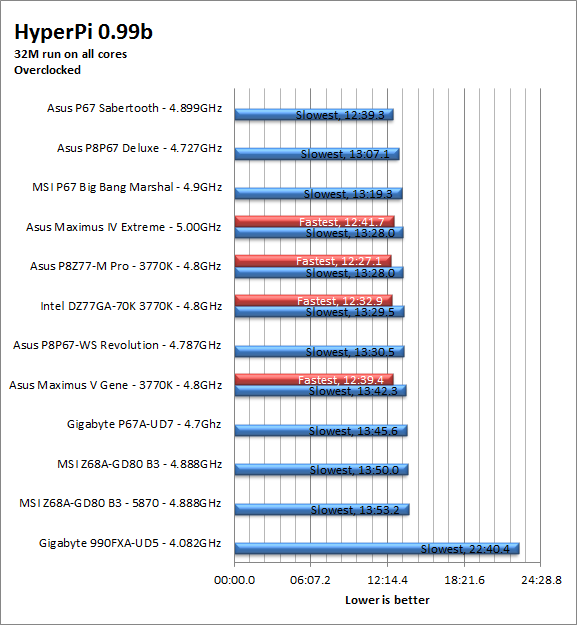
Cinebench R11.5 -
Cinebench R11.5 is the 11th release of Maxon’s rendering test. This test is based off of the Cinema 4D engine, which is one of the industry standard tools for digital animation. It is a powerful product with many different modules that can be “plugged” into it to increase its effectiveness. With Cinebench you get to see how your computer would do using this application. There are two tests; one tests the CPU’s ability to render an image across multiple cores or threads. The other tests your systems ability to handle OpenGL based rendering. 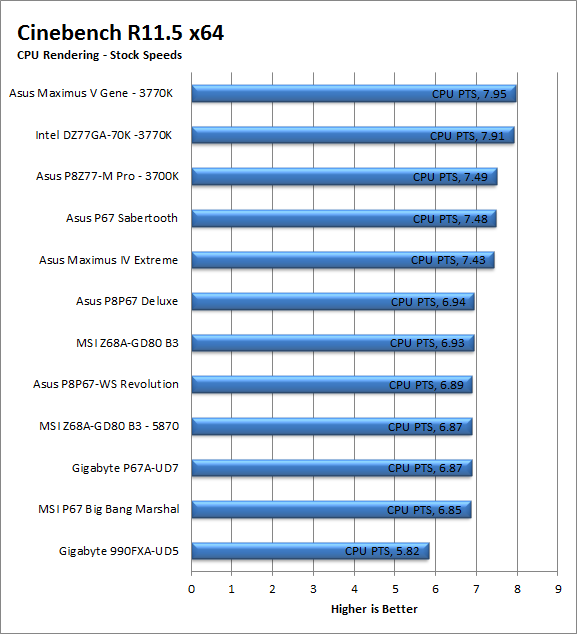
Under Cinebench we see similar results to our HyperPi testing. The P8Z77-M Pro comes in over all of the P67 boards but behind for the Z77 boards. The same thing happened again during our overclocked testing. The M Pro manages to outperform the Maximus V Gene at the same clock speed.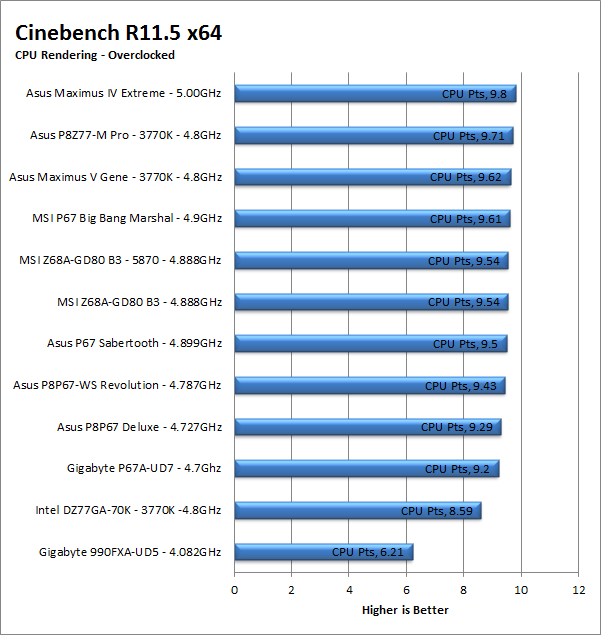
We see the opposite for the Z77 boards for the OpenGL rendering tests though.
| Cinebench R11.5 OpenGL Stock | Cinebench Open GL Overclocked |
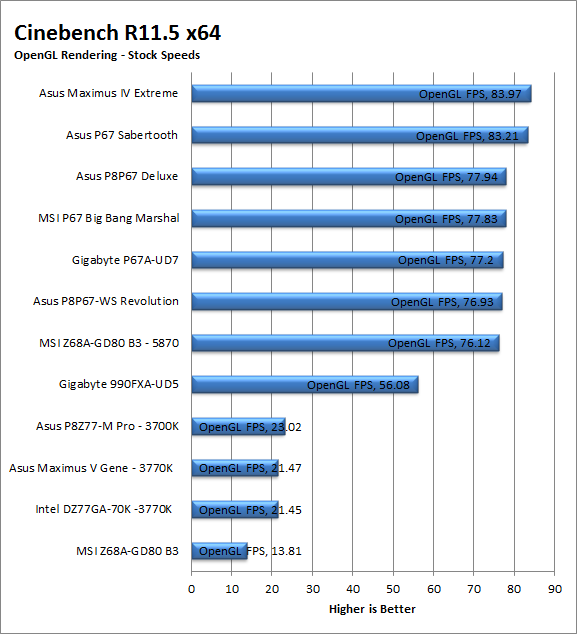 |
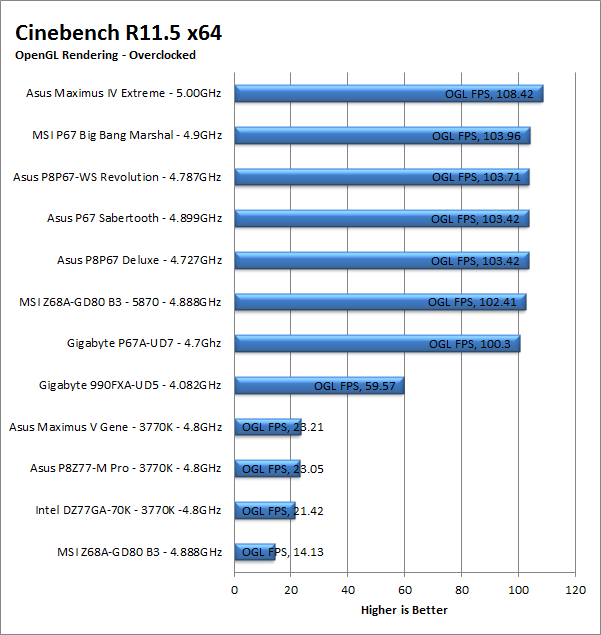 |
Section III - Performance Tests,
Real-World
Here we have two tests that are designed to put the performance of the motherboard and its subsystems to the test. Both require good CPU, Memory, HDD and even to a lesser extent audio and network performance. The two tests we chose were Lightwave 3D 9.6 and AutoGK 2.55. We will be adding at least one more real-world test to this battery in the near future, but for now these two cover quite a bit.
Lightwave 3D 9.6 x64
Lightwave is another industry standard application for 3D animation and rendering. It has a large tool base and the rendering engine is highly threaded (when using the right render model). This application is also capable of expanding to 4k resolutions as well as ray tracing for rending the light sources. For our testing we use frame 470 of the Pinball scene found in the LW 9 Content folder. This uses the newer perspective camera that is better suited to a multi-CPU/Core environment. This camera style also uses ray tracing and a much improved anti-aliasing method. Settings are shown below in the attached screen shot. Of course these are single frame renders and they are not a complete picture; for that you have to take into account the number of frames an average project would have. In a typical 30 second commercial you will have around 840 to 960 frames (at 28 – 32 FPS) this means that you have to multiply the time of a single frame by that number just to get a vague idea of how long that 30 seconds would take. This is because each frame will have a different render time based on complexity.
Under the stress of LightWave 9.6 x64 the M Pro again shows that it is much faster than the P67 boards (when using an Ivy Bridge CPU). When overclocked to 4.8GHz it even manages to push past both of the other Z77 boards in the test group.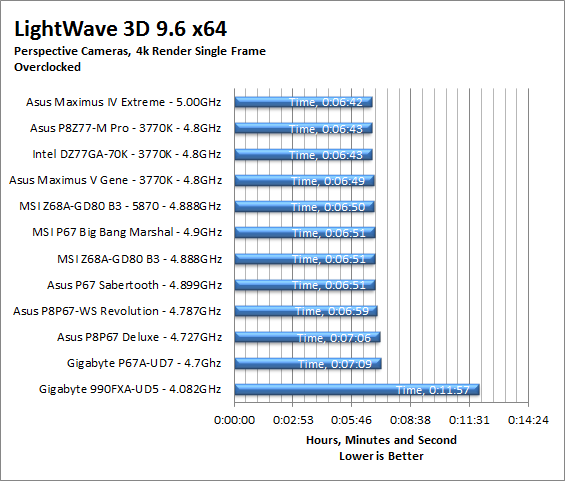
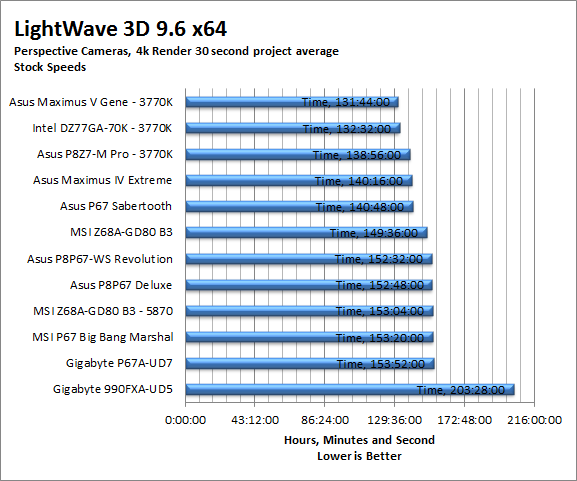
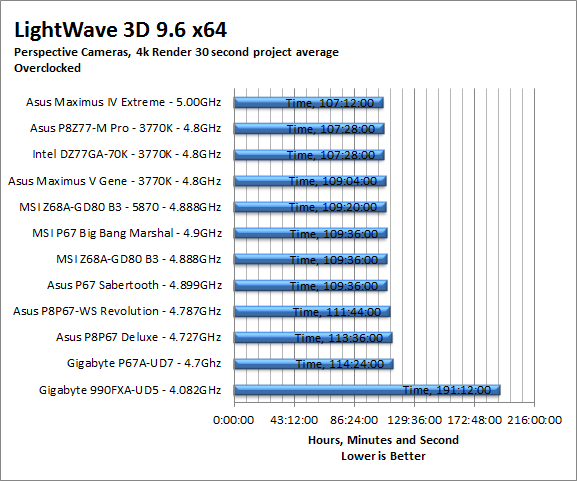
CyberLink Media Espresso 6.5 -
After having various issues with AutoGK and Intel CPUs with more than four cores we have changed our Media Encoding test to use Media Espresso from CyberLink. Although this new utility does not have the same ability to transfer directly from DVD it is still a good test to transfer different media types into a usable format for your iPad, iPod, or other media player. Our test involves using multiple (Six) 20 minute media files and transcoding them for an iPad. This gives us a very good indication of how well a motherboard can handle this type of work load.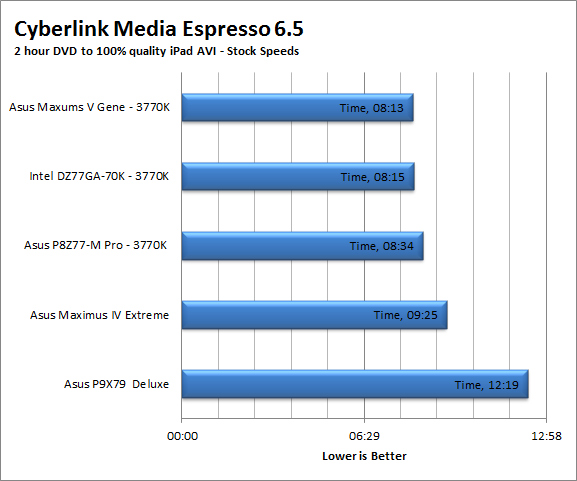
In our transcoding tests with CyberLink’s Media Espresso we found that once again the Asus P8Z77-M Pro was a quick and nimble motherboard. It was able to crunch through our two hour video in about 8.5 Minutes which is simply amazing considering the time ratio here. Of course these times are also comparing Ivy Bridge to a Sandy bridge CPU. 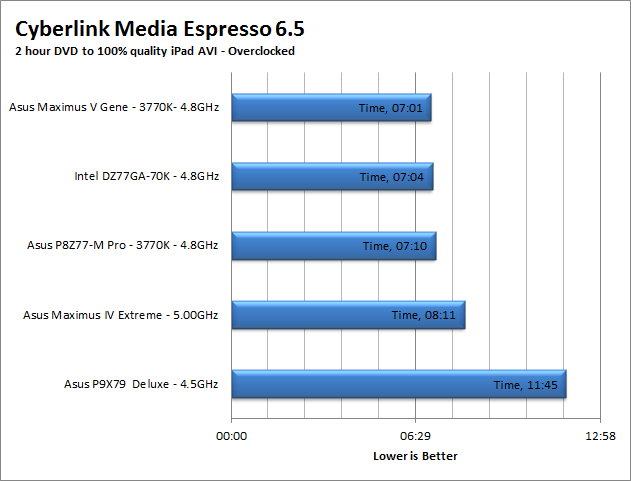
Section IV Performance,
Gaming
Gaming as a test of motherboard performance is sort of a joke these days. The big player in the gaming arena is the GPU. Everyone but a few hardcore PR teams know this. However, it is important to run at least a few (one from each current DX version) to see if there are any issues with the combination of components on a motherboard. These are items like Audio lag, memory lag and of course problems with the PCIe lanes and signal traces. If there are issues in design, drivers or BIOS then you can have odd gaming performance. So without much more preamble let’s dive into the three games we currently use; Call of Duty Modern Warfare 2 for DX9 FarCry 2 for DX10 and Battlefield Bad Company 2 for DX11.
Call of Duty Modern Warfare 3 DX9 -
As the third installment in the Modern Warfare franchise you are picking up some old roles while adding a couple of new ones as well. The game play is almost identical to what you are used to in Modern Warfare 2 as are the graphical settings. The AI is a little different thought it is still similar to the bar fight style AI we like in the Call of Duty series. For our testing we run the first mission (Black Tuesday) from start to finish. Settings are shown below
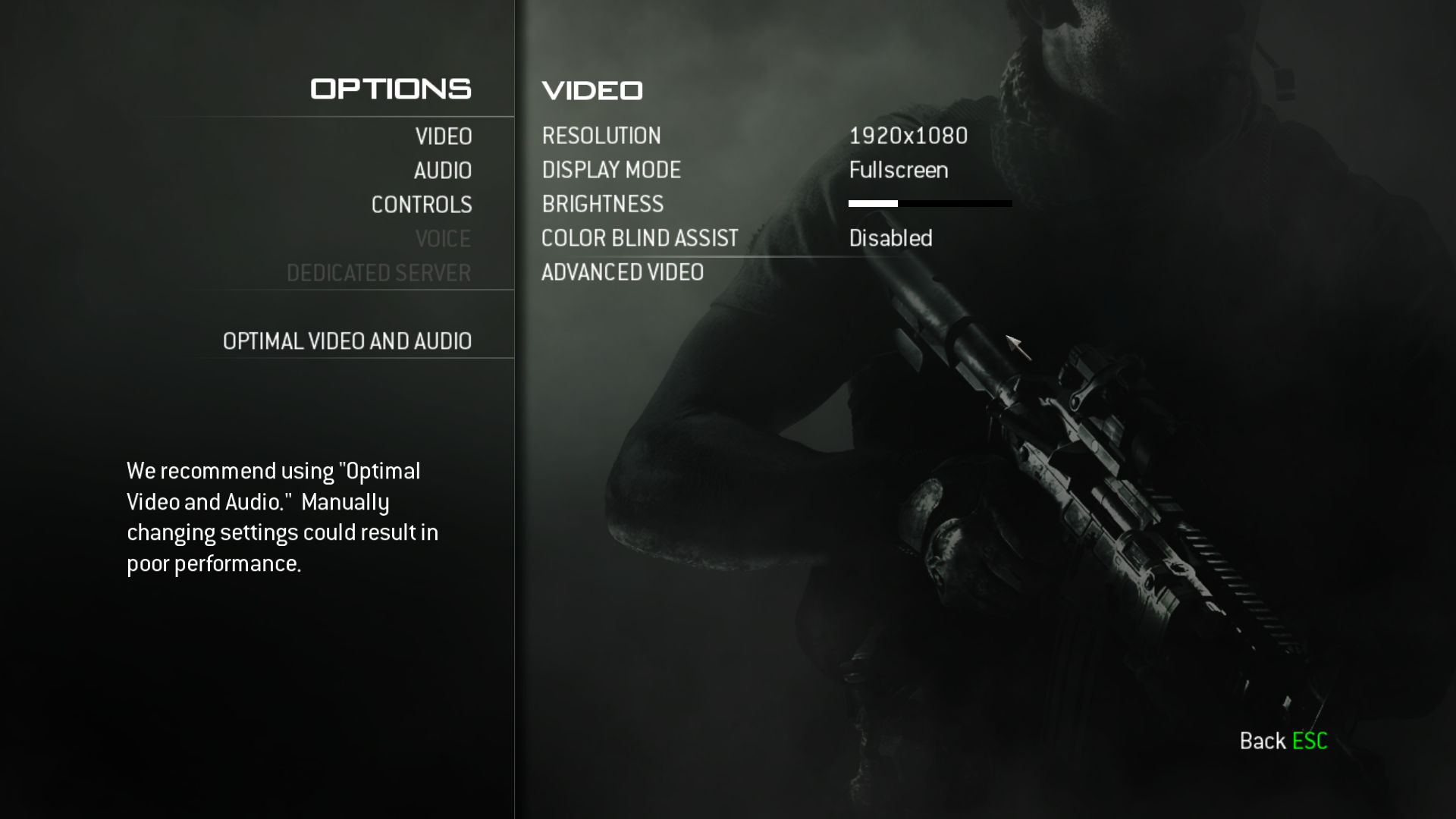 |
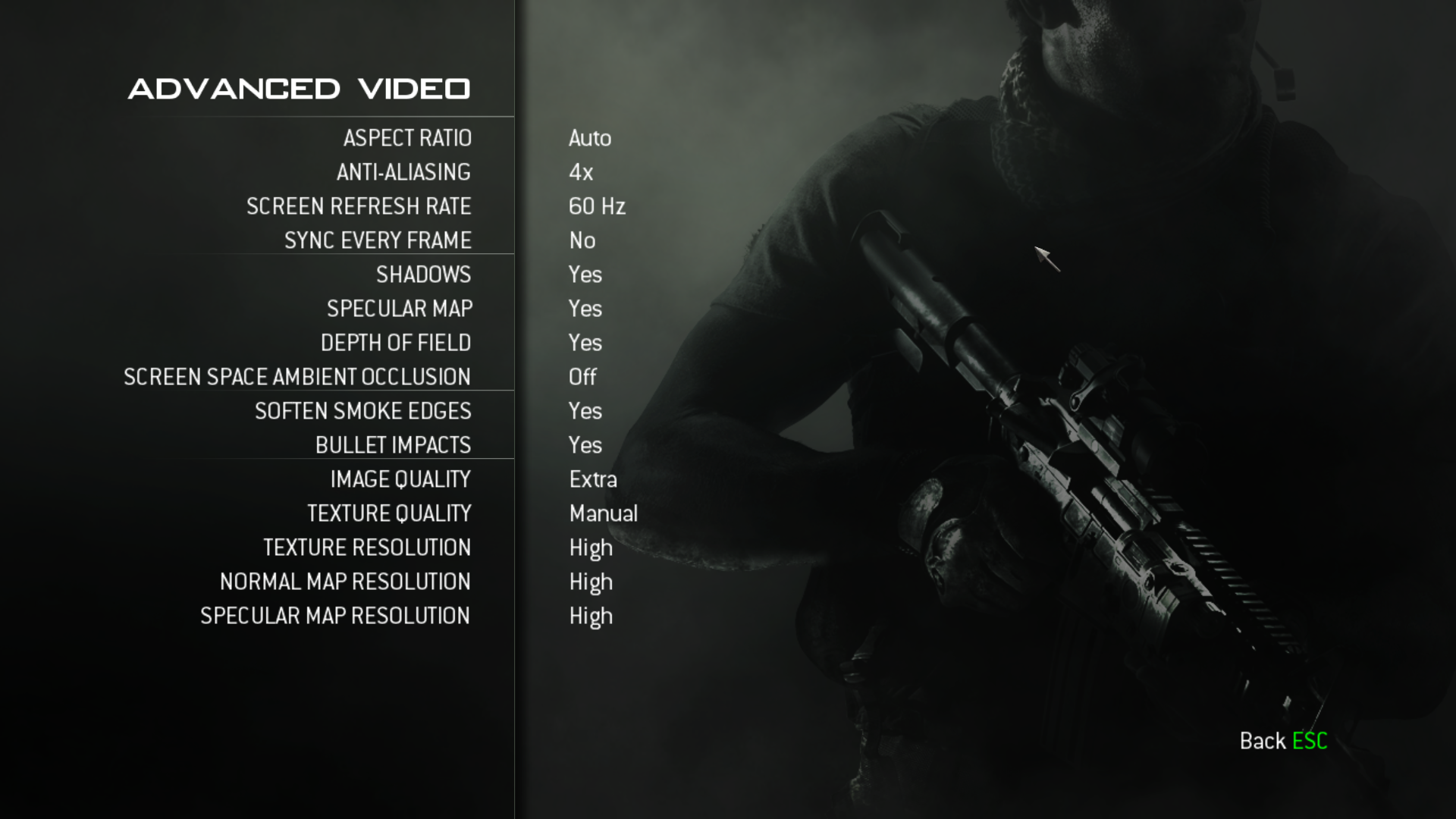 |
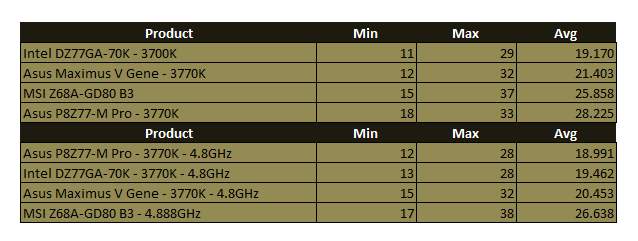
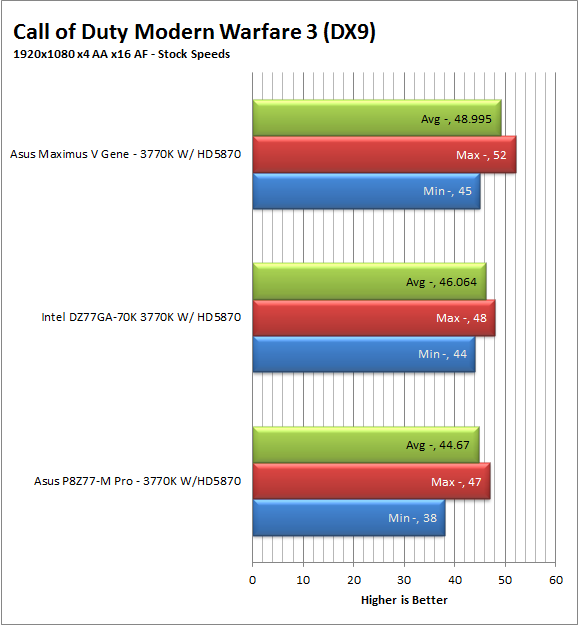
The Asus P8Z77-M Pro does very well running under the IGP when playing Modern Warfare 3 at 1920x1080. When we dropped in our HD8570 it fell behind, not drastically but enough that you would might notice it if you were paying very close attention.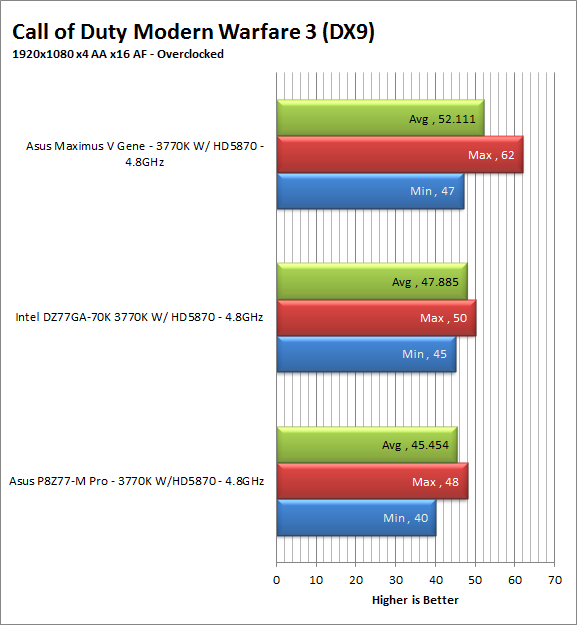
FarCry2 DX10 -
Although not one of my favorite games this tedious game does have some good graphics. The large sandbox style of the game lends to mission based play. The only problem is that the AI is rather low grade. Still the more CPU power the more the bad guys try to do. Over all the game was a little bit of a disappointment to play, but still not a bad DX10 representation. Our testing run starts right after you get your first mission to clean out the safe-house and ends after the hostage rescue. Settings and performance numbers are shown below.
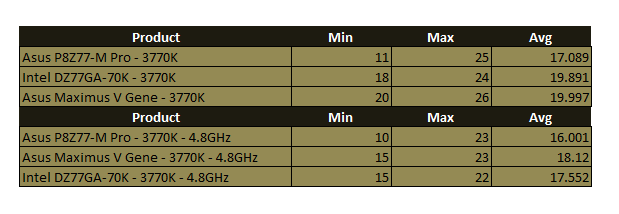
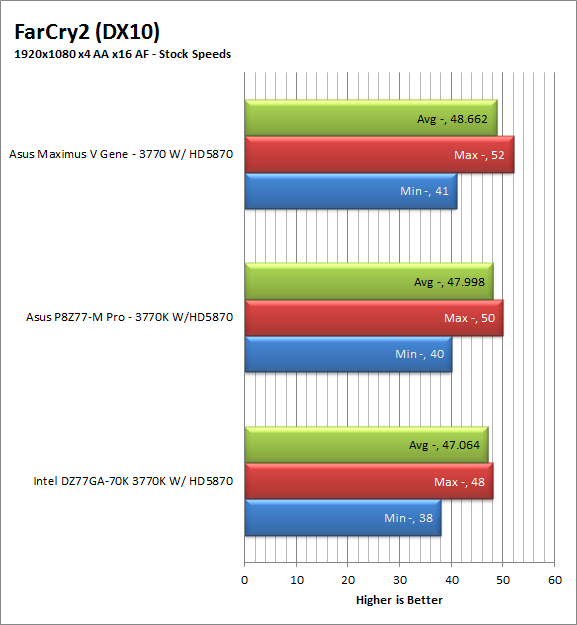
Although we would not recommend playing FarCry2 on the Intel GMA4000 we did just to give you a point of reference. Under the strain of the DX 10 engine in FarCry2 we saw the M Pro lag a couple of FPS behind the other two Z77 boards. Of course all of them were like watching a slide show so you would never know it to see them side-by- side. The same thing can be said for the frame rates when running the HD5807.They honestly were so close that it would not matter in the real world. 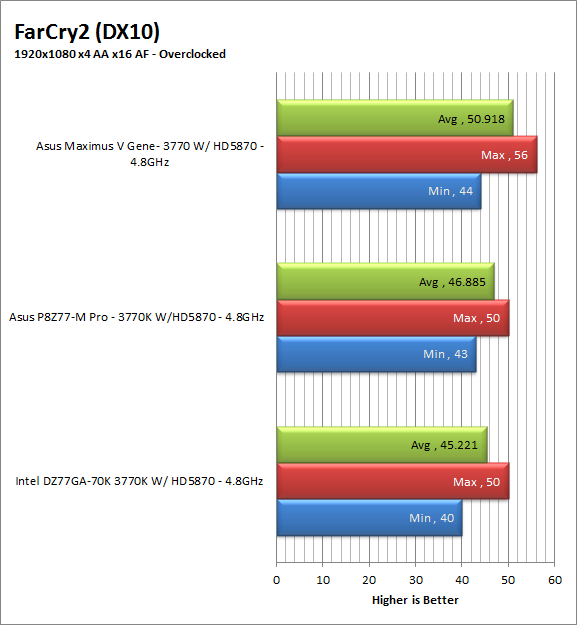
Crysis 2 DX11 –
Another sequel Crysis 2 follows up on two other Crysis games (making the title a little misleading). You take the role of a Force Recon Marine who is given a battle suit by a character named Profit (you will remember him from the other two Crysis games). From there you run around an Infected and Invaded New York City trying to survive and, of course, save the planet. For our testing we ran through the first “mission”. Settings are shown below.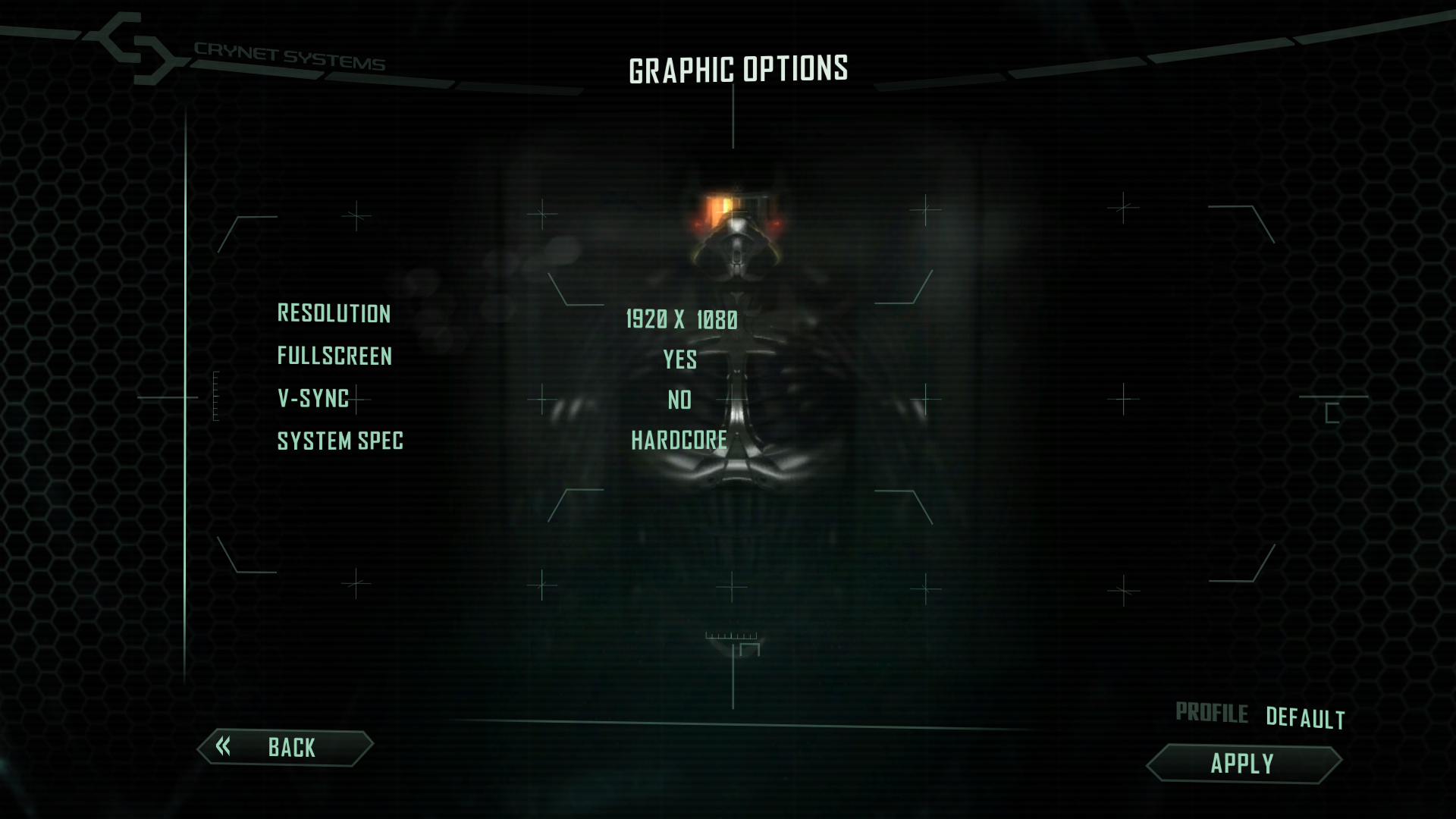
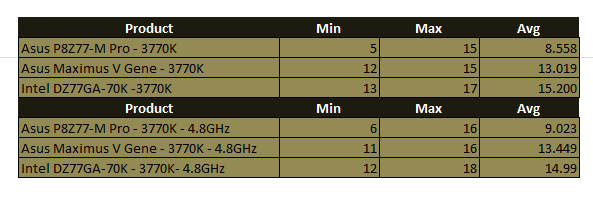
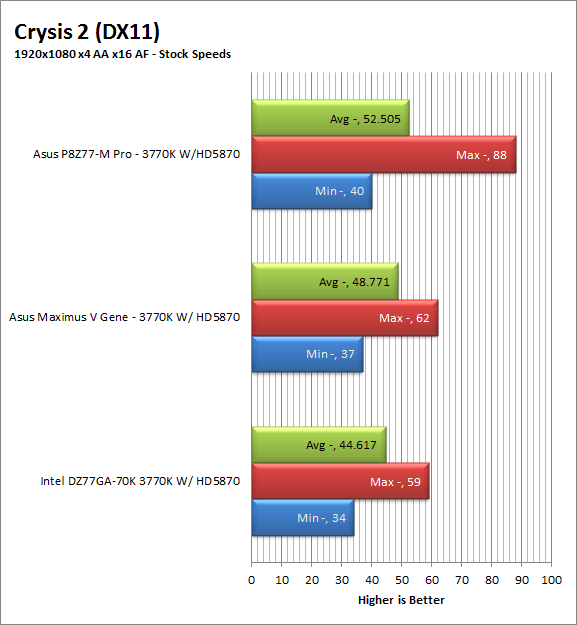
Crysis 2 was not playable on any of our Z77 motherboards running the GMA4000 (which is ok as it is not meant to run games like Crysis 2). Even so for some reason the M Pro took a bigger hit than the other two with frame rates that were almost half what we saw on the others. Conversely the M Pro managed an upset when we had the HD 5870 running. Again it is important to note that the delta here is so small that you would never know it if they were running side-by-side.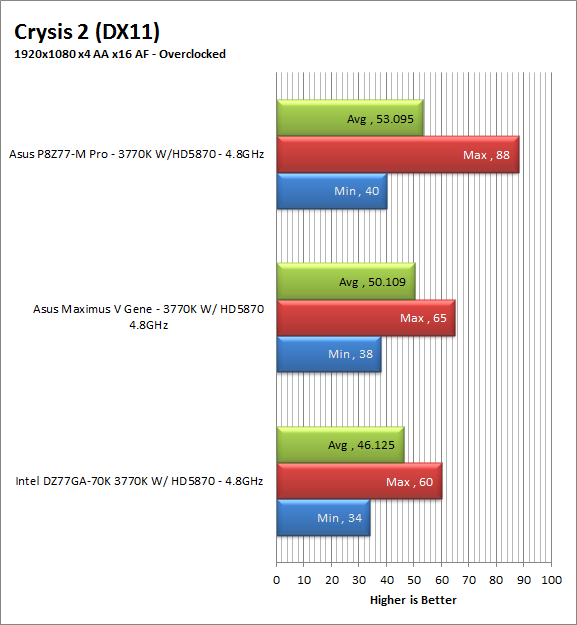
Gaming wrap-up -
If you were thinking of getting the Asus P8Z77-M Pro for a small and inexpensive gaming rig you would not have made a bad decision. It can game quite well with the right components in the system. The audio is not the best you could hope for, but you do have room to a solid add-in card if you just have to have the best audio for your games. The Network iControl function was a benefit here as well. We were able to get a couple of games added to the priority listing quite easily which did give us a slight improvement on ping times during online game play. If you were thinking about using the IGP for gaming; well you can do that, but remember that it was designed more for multi-media playback with some mainstream gaming support. Do not expect to run the Asus P8Z77-M Pro with any of the Intel GMAs with games like Crysis2 it was not what Intel meant them for.
Value -
Value is another very subjective topic. What is expensive to some might be a deal to others. You can look at this topic in multiple ways. One is raw price and the other is what you get for the money. Each is accurate and both are correct ways to look at price/value. We tend to look at features, performance and real-property when we discuss value. However, we also take into account the raw cash cost of the item. The Asus P8Z77-M Pro will only cost you $160 from most online stores. This is an exceptional price considering the performance and feature set that we have seen here. We can really understand people’s interest in this board. Even the enthusiast market will want to give this board a look as it much more capable than its modest price tag would indicate.
Conclusion -
The Asus P8Z77-M Pro is an entry level product with some enthusiast class features and performance. Although it cannot really match up to what you get with boards like the Maximus V Gene or the V series it is more than capable and will not leave a crater in your wallet. Asus has a good product on their hands and we think they are very aware of it. When we first showed our readers that we had one of these in the lab the requests for information on it were a little surprising. Now, as we said, we completely understand. This is a great board for multiple uses from gaming to general computing. Asus’ move to provide features to the each market that make sense is really showing here. As a value proposition it certainly is one. 
The P8Z77-M Pro has more than earned the Gold Key award from us with the excellent performance, overclocking and exceptional value it brings to the market.
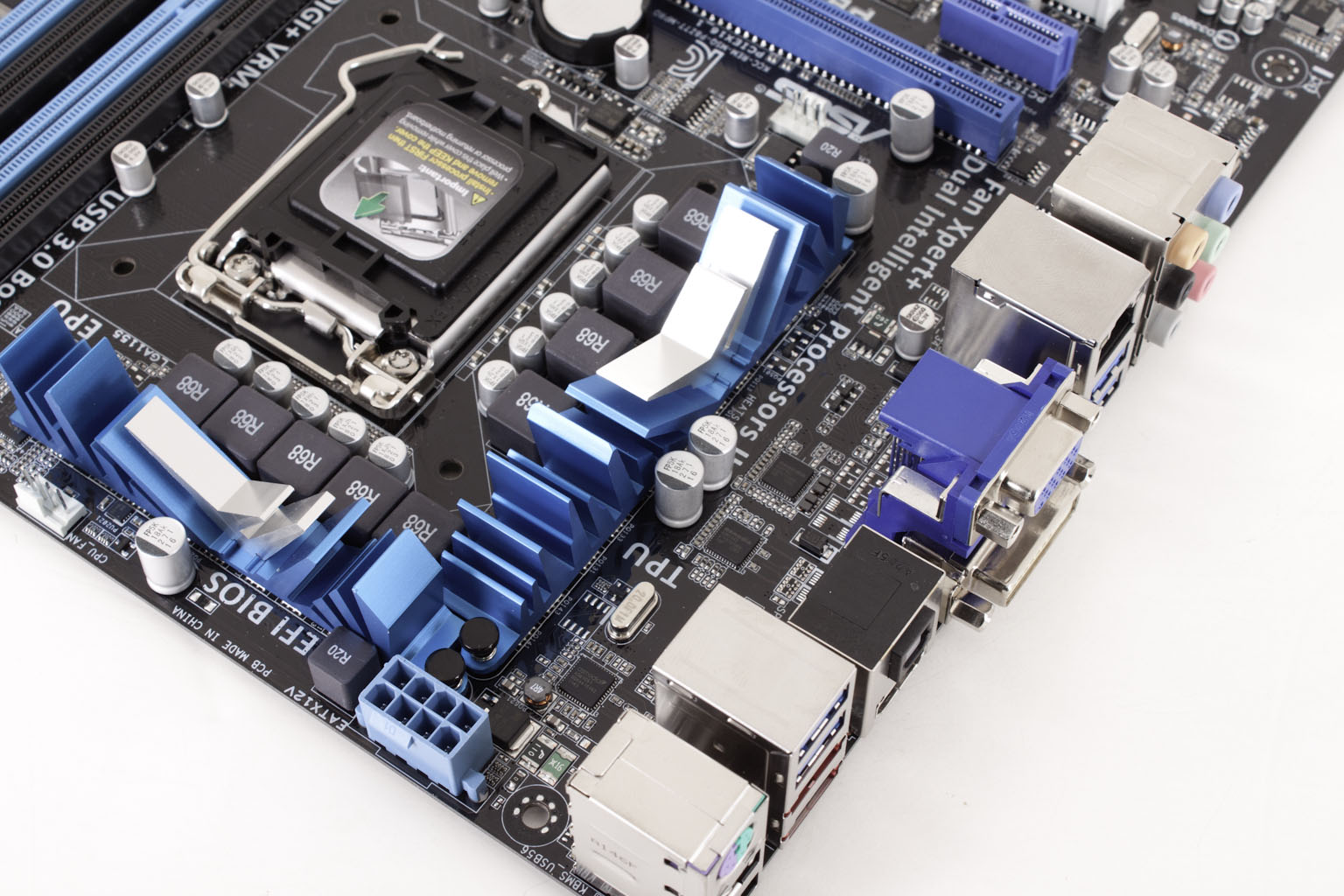 At almost the opposite end of the spectrum from the Asus Maximus V Gene (in terms of target market) we find the Asus P8Z77-M Pro motherboard. The P8Z77-M Pro is also a micro ATX board and despite being aimed at the lower end of the consumer market it shares some of the same features that the Gene has. You still get Asus’ Digi+ power controls and FanXpert+ along with Asus’ commitment to solid design and component selection. We have talked about most of these items in
At almost the opposite end of the spectrum from the Asus Maximus V Gene (in terms of target market) we find the Asus P8Z77-M Pro motherboard. The P8Z77-M Pro is also a micro ATX board and despite being aimed at the lower end of the consumer market it shares some of the same features that the Gene has. You still get Asus’ Digi+ power controls and FanXpert+ along with Asus’ commitment to solid design and component selection. We have talked about most of these items in